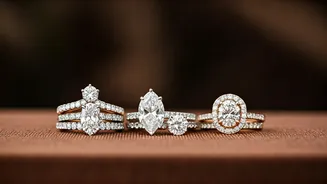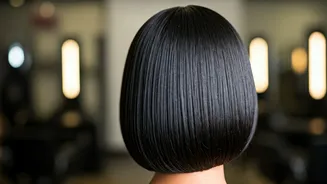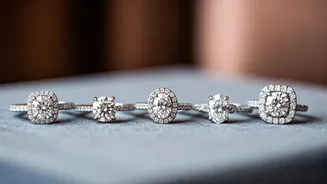Royal Jewellery's Legacy
The British royal family’s jewellery is more than just adornment; it's a tangible link to history, representing both personal stories and the grand narrative
of the monarchy. These exquisite pieces have been passed down through generations, each one reflecting the era it emerged from while carrying the echoes of the women who wore them. Royal jewels act as emblems of status and tradition, carefully curated and preserved to endure the test of time. These treasures often hold deep personal meaning, connecting the wearer to previous generations and symbolizing the continuity of royal lineage. When a jewel is gifted or inherited, it's not merely a transaction; it's an act of bestowing a piece of history and a symbol of familial bond, ensuring that these remarkable pieces live on. The significance of royal jewels is further amplified by their public appearances. Whether gracing state banquets or adding sparkle to official portraits, the jewellery often becomes a focus of public fascination. This exposure not only celebrates the individual beauty of each piece, but also highlights their role in shaping the image and maintaining the allure of the monarchy.
Diana’s Timeless Elegance
Princess Diana’s jewellery collection had a profound impact on the public and fashion trends, reflecting her grace and humanitarian spirit. Her choices often conveyed a personal message, turning each piece into a statement. A notable example is her iconic engagement ring, now worn by the Princess of Wales, Catherine. This ring, a stunning sapphire surrounded by diamonds, was not just a symbol of her engagement but also a reflection of her unique style and commitment to making her own choices. Diana's jewellery was characterised by a blend of classic elegance and modern flair. She favored pieces that were both beautiful and meaningful. Her necklace collection included several show-stopping chokers, worn with great versatility, and pearl pieces, often paired with bold dresses. Beyond their beauty, her jewellery selections reflected a desire to connect with the public. Diana was known for wearing pieces that resonated with her, offering an intimate glimpse into her world. Her influence extended beyond the aristocracy, captivating the public and setting fashion trends that have lasted through time. Princess Diana's jewellery became a cultural phenomenon.
Meghan’s Modern Touch
Meghan Markle, the Duchess of Sussex, brought a fresh, modern sensibility to royal jewellery, incorporating both classic and contemporary styles. Her choices often reflect her personal values and a sophisticated sense of design. One standout example is the engagement ring, which incorporates diamonds from Princess Diana's collection. This piece, designed in part by Prince Harry, served not only as a symbol of their union, but also as a way of honouring his mother's legacy. Meghan's style is marked by a blend of traditional and modern elements. She often pairs understated, elegant pieces with minimalist designs, creating a sense of understated luxury. Her choices frequently make an impact, whether she is wearing a simple gold necklace or elaborate earrings. The Duchess often chooses jewellery with a symbolic significance. Her public appearances often feature pieces that hold personal importance, like delicate necklaces bearing significant initials or bracelets with specific meaning. This approach allows Meghan to connect with her audience while demonstrating her own values and individuality. Her choices have made a mark on how modern royal jewellery can be both relevant and expressive.
Symbolism in Design
Jewellery within the British royal family is steeped in symbolic meaning, reflecting heritage, values, and personal stories through its intricate designs. The choice of materials, from the sparkling brilliance of diamonds to the warm tones of gold, often signifies wealth, power, and prestige. Gemstones themselves carry unique meanings, with sapphires representing loyalty and wisdom, emeralds symbolizing hope, and rubies embodying passion. The shapes and patterns used in the jewellery designs also offer symbolic significance. Royal tiaras, for example, often feature intricate floral motifs, representing growth, renewal, and a connection to nature. The use of certain patterns and motifs shows the wearer's relationship to history and tradition. Jewellery in the royal collection often serves as a form of non-verbal communication, with each piece carrying a rich narrative of significance. When royal members wear pieces, they convey messages of unity, continuity, and personal connection. Whether a family heirloom or a newly commissioned piece, the jewellery's design elements are carefully considered, ensuring that it communicates a certain message, be it about personal significance, royal lineage, or the values held by the monarchy.
Heirlooms and Legacy
Heirloom jewellery within the royal family plays a crucial role in preserving the family’s heritage, acting as a tangible link to the past while carrying family history and values. These pieces are not just elegant adornments, but vital symbols of continuity and identity, representing the enduring legacy of the monarchy. Each inherited jewel is a reminder of those who came before, connecting current royals with their ancestors. The act of passing down these pieces from one generation to the next solidifies the bond between family members and reinforces shared identity. Heirlooms often come with stories and memories, which are shared along with the jewellery itself, enriching their significance with personal narratives. Royals often modify and update these historic pieces to match current styles and preferences while keeping the original intent. This practice ensures that the heirlooms remain relevant and appreciated for future generations. Preserving and celebrating the legacy of heirloom jewellery reflects the values of tradition, history, and the profound significance of family within the monarchy. This ongoing transmission of jewellery is a visible reminder of the past and a commitment to preserving the royal family's ongoing story.







